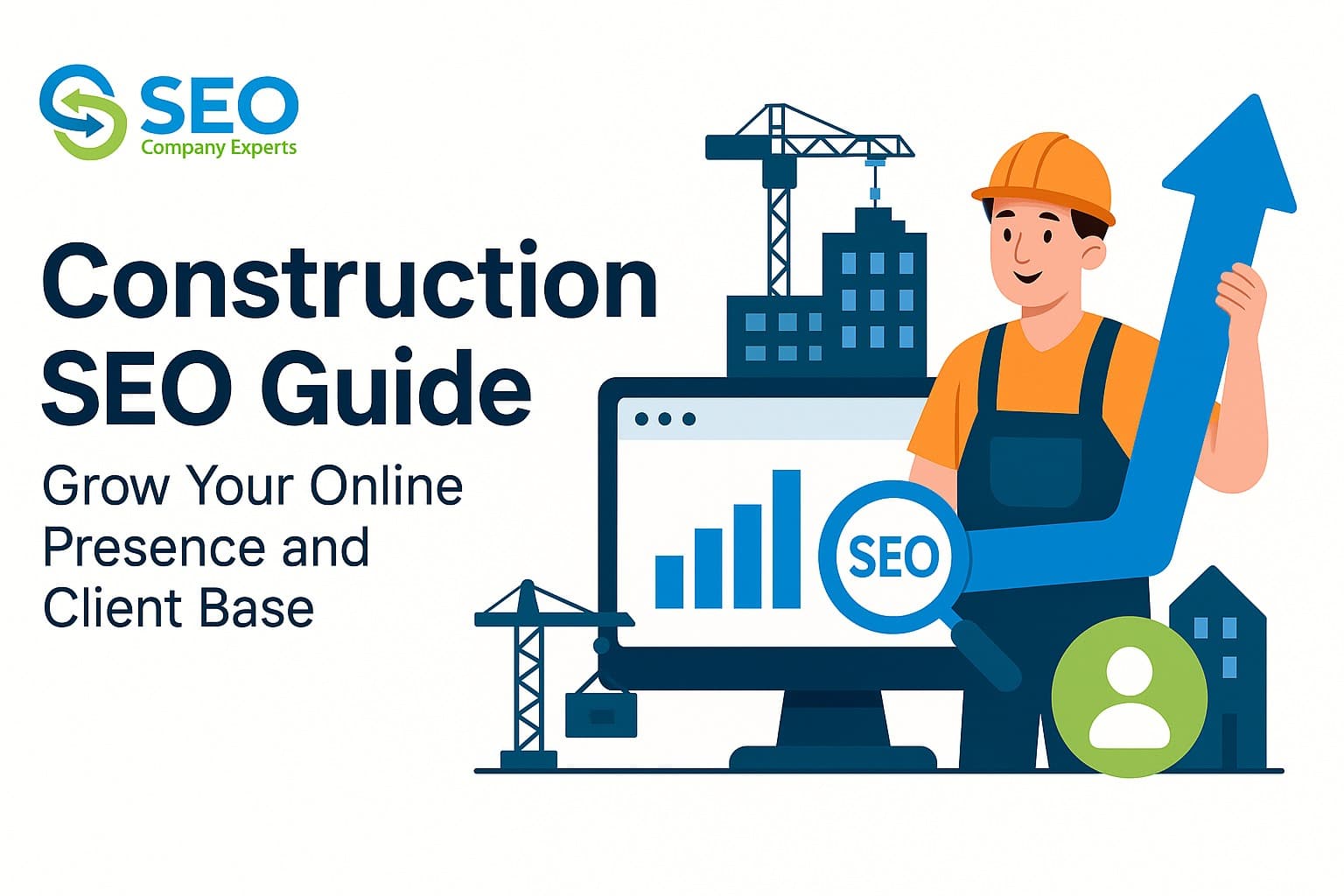

In the competitive construction industry, standing out online isn’t just an advantage—it’s a necessity. This comprehensive Construction SEO Guide is crafted for contractors, builders, and construction firms looking to improve their digital footprint, attract qualified leads, and drive sustainable business growth. By following proven strategies in this guide, you’ll learn how to use SEO to expand your reach and convert site visitors into loyal clients.
Why Construction Company SEO Matters for Modern Builders
In an industry that traditionally relied on referrals and local advertising, digital transformation has shifted how customers search and hire contractors. Construction company SEO isn’t just about ranking higher—it’s about being present where your audience is looking. Here’s why investing in SEO is no longer optional for construction businesses:
The Digital Shift in the Construction Industry
From searching for local contractors to reviewing portfolios and reading testimonials, your potential clients are online. If you’re not visible on Google, you’re missing out on opportunities your competitors are capturing. A strong SEO presence ensures that when property owners are ready to hire, your company shows up first with authority, credibility, and trustworthiness.
Key Benefits of SEO for Construction Companies
- Boost visibility on Google Maps and organic results.
- Generate quality leads by targeting specific search intent.
- Enhance trust through content and local reviews.
- Save money on paid ads with long-term organic growth.
Construction Industry SEO Trends Worth Noting
The industry is seeing increased demand for mobile-optimized sites, local voice search, and rich results (e.g. FAQs, “People Also Ask”). Staying on top of construction industry SEO trends ensures you don’t fall behind. Emerging practices like AI-driven search, schema markup, and video marketing also play a key role in keeping your construction business competitive and visible in today’s fast-changing digital landscape.
Understanding SEO for Construction Companies: The Foundation of Visibility
Before diving into tactics, you need to understand how SEO for construction companies works. It’s more than just sprinkling keywords—it’s about aligning your website with how search engines rank content and how users interact with it.
What Makes Construction SEO Different?
Construction companies need a local-first, service-specific approach. Unlike eCommerce or SaaS SEO, you’re optimizing for service areas, licenses, trust signals, and visual project proof. Potential clients want proof of quality, reliability, and expertise before choosing a contractor, making elements like project galleries, certifications, and reviews just as critical as ranking high on Google searches.
Three Pillars of Effective SEO for Builders
- On-page SEO: Creating optimized content, using keyword-rich headers, and internal linking.
- Off-page SEO: Getting links from directories, construction blogs, and customer reviews.
- Technical SEO: Ensuring fast load times, mobile responsiveness, clean code, and secure browsing.
Matching Content to Search Intent
Not all traffic is equal. Builders should target a blend of informational keywords (e.g., “how to rank a construction website”) and transactional ones (e.g., “general contractor in Dallas”) to attract users in different buying stages. By aligning content with search intent, you capture homeowners researching ideas as well as ready-to-hire clients, creating a steady pipeline of qualified leads.
Keyword Strategy for Construction SEO: What to Target and Why
A strong SEO strategy starts with keyword research. To grow your traffic, target high-volume and intent-rich keywords that people are already searching. Well-placed keywords help attract qualified leads, improve rankings, and ensure your website aligns with user search intent.
Primary Construction SEO Keywords to Focus On
Include the following high-intent, high-volume terms throughout your content and headers:
- Construction company SEO
- SEO for construction companies
- Construction SEO guide
These form the backbone of your visibility strategy and match common search behavior. Consistently integrating these terms into service pages, blogs, and metadata builds a solid foundation for ranking success and online credibility.
Long-Tail and Secondary Keywords to Drive Targeted Traffic
Long-tail keywords may have lower search volumes, but they attract more qualified leads. Use these throughout blogs and FAQs:
- local construction SEO tips
- how to rank a construction website
- SEO tips for construction
- increase construction website traffic
These keywords help target niche queries, connect with customers at different buying stages, and increase conversion rates by addressing specific needs that broader terms often miss.
Tools for Keyword Research
Use Google Keyword Planner, Ahrefs, or Semrush to find keyword opportunities. Include “People Also Ask” data to align with current search behavior and capture featured snippets. Regularly updating your keyword list based on trends ensures your SEO strategy stays competitive and continues delivering measurable results over time.
On-Page SEO for Construction Companies: Build a Strong Website Foundation
Proper on-page SEO ensures Google can understand your content and rank it appropriately. This is where your keyword strategy, site structure, and content optimization come together. A strong on-page foundation improves visibility, builds authority, and makes it easier for potential clients to find and trust your construction services online.
Optimizing Titles, Meta Descriptions, and URLs
Your page titles and meta descriptions are your first chance to attract clicks. Use power words, incorporate primary keywords, and keep them within optimal character limits. Well-optimized URLs should also be short, descriptive, and easy to read, which increases both search engine crawlability and user trust.
Using Headers to Organize Content and Boost Readability
Structure your content using a clear H1 > H2 > H3 hierarchy. This helps Google crawl your site and improves user experience. Include keywords in subheadings naturally. Organized headers guide visitors through content logically, keeping them engaged while reinforcing relevance for search engines and supporting higher rankings.
Content Formatting Best Practices
- Use short paragraphs and bullet lists for readability.
- Include visuals, charts, and service photos.
- Ensure mobile-friendly text flow and large tap targets.
Image Optimization with SEO in Mind
All images should include descriptive file names and alt text with keywords such as “modern kitchen remodel Chicago” or “roofing contractor SEO best practices.” Compress images to improve load speed and use web-friendly formats. Optimized visuals enhance both accessibility and search performance, giving your construction site a competitive edge.
Local SEO for Construction: Show Up in Nearby Searches
Nearly half of all Google searches have local intent. For construction businesses, this means optimizing for service areas is critical to capturing leads. Local SEO helps contractors dominate map listings, attract nearby clients, and establish long-term trust with their community.
Why Local SEO is Crucial for Construction Companies?
Whether you’re a general contractor, plumber, or builder, your clients search for services by location. Local SEO ensures you appear in maps, directories, and local search results. This visibility positions your business as the top choice in your area, driving qualified leads who are ready to hire.
Top Local Construction SEO Tips to Implement Now
- Optimize your Google Business Profile with accurate info, photos, hours, and services.
- Build citations on Yelp, Angi, Houzz, and local chambers of commerce.
- Create geo-targeted service pages (e.g., “home builder in San Diego”).
- Encourage reviews and respond to them to boost credibility.
Bonus Tip: Compare with Local SEO for Travel Businesses
While travel relies on destination-based keywords, construction relies on hyper-local services. Understanding these differences sharpens your approach and outreach.
Off-Page SEO for Construction: Build Trust and Authority
Off-page SEO is about more than just backlinks—it’s about building your reputation in the digital space. For construction companies, trust is everything, and being recognized by other credible websites, directories, and communities signals that your brand is reliable. From industry-specific mentions to positive client reviews, strong off-page efforts help you rise above competitors, strengthen authority, and win long-term clients through consistent visibility.
How to Earn Backlinks that Build Your Construction Brand
- Guest post on contractor blogs, real estate sites, and renovation forums.
- Share project features with suppliers or local associations for links.
- Use broken-link outreach by offering your content as a replacement.
Internal Linking: Strengthen Your Website’s Structure
Connect related service pages and blog posts to establish topical relevance and guide users through your content funnel. Internal linking also distributes authority across your site, improves crawlability, and encourages visitors to explore multiple pages. This creates a smoother user journey, improves engagement, and increases the likelihood of turning casual visitors into qualified leads.
Gather Reviews, Testimonials, and Social Proof
Online reviews are powerful ranking factors and build client trust. Ask for reviews after every job and showcase them with client logos and project details. Highlighting testimonials on service pages and linking them to case studies can strengthen credibility further. Active management of reviews also shows potential clients that you value feedback and maintain professional standards.
Content Strategy That Attracts Clients and Ranks High
A well-planned content strategy keeps your website fresh, informative, and visible in search engines. By consistently publishing targeted, high-quality content, construction companies can build trust, attract leads, and strengthen long-term authority online.
Content Ideas for SEO Success
- Case studies
- How-to guides
- Project showcases
- Lead magnets and checklists
Topic Clusters: Organize Content for Deeper Authority
Group your blog posts around key themes and link them to your main service page. This boosts your relevance and helps Google understand your site’s hierarchy. Topic clusters also keep users engaged longer, encourage exploration of multiple pages, and improve your chances of ranking for competitive, high-value keywords in the construction niche.
Technical SEO for Builders: Optimize Site Health and Performance
Great content means nothing if your site is slow, buggy, or hard to navigate. Technical SEO ensures everything works smoothly behind the scenes. For builders, this means creating a website that loads fast, works across all devices, and provides a seamless user experience. A technically sound site builds trust with clients and search engines alike.
Make Your Site Mobile-Friendly and Fast
Use responsive design, compress images, and limit third-party scripts to speed up your site. Google prioritizes mobile performance in its rankings. Fast, mobile-optimized pages not only help rankings but also keep potential clients engaged, lowering bounce rates and increasing inquiries from homeowners browsing construction services on their phones.
Use Schema Markup to Win Rich Snippets
Implement FAQ, review, and local business schema to increase your chances of appearing in featured results, which dramatically improves click-through rates. Schema also helps Google better interpret your services, reviews, and contact details, giving your construction company a stronger chance of dominating search results with enhanced, eye-catching listings.
Maintain a Clean Site Structure
Ensure your site is easy to navigate, has working internal links, and includes a clear sitemap. Remove duplicate pages and fix crawl errors using Google Search Console. A clean site structure improves crawlability, supports keyword targeting, and provides a user-friendly experience that guides visitors smoothly toward contacting your construction business.
Track, Measure, and Adjust Your SEO Strategy
SEO is not set-it-and-forget-it. Monitor your progress and stay flexible as the digital landscape evolves. For construction companies, tracking results ensures marketing investments directly translate into qualified leads and measurable growth.
Key Metrics to Watch
- Organic traffic trends
- Keyword rankings for primary and local terms
- Bounce rate and average time on page
- Monthly leads and conversion rate
Stay Ahead with Construction Industry SEO Trends
Voice search, AI summaries, and visual search are changing how people discover contractors. Keep learning and optimizing to stay competitive. Follow algorithm updates and test new strategies early to maintain visibility.
Conclusion
In today’s digital-first environment, construction companies must embrace SEO not as a one-off task but as a foundational business strategy. From local-first keyword targeting and technical optimizations to compelling content and authority-building backlinks, this guide arms builders with the tools to boost visibility, attract qualified leads, and outpace competitors.
By consistently tracking metrics and adapting your approach based on performance, you’ll ensure sustained growth and long-term ROI. Ready to elevate your online presence? Begin with a focused audit, implement the proven strategies covered here, and stay proactive—your next project lead could be just one optimized search away.





